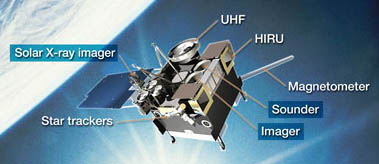GOES N - P

Geostationary Operational Environmental Satellite
Phase: Development
Launch Date: March 04, 2010
Mission Project Home Page - http://goespoes.gsfc.nasa.gov/
Program(s):GOES / POES
Launch Dates:
- GOES N – 5/24/2006
- GOES O – 6/27/2009
- GOES P – 3/8/2010
GOES - N/O/P is the next series of GOES satellites. The multi-mission GOES series N - P will be a vital contributor to weather, solar, and space operations and science. The National Aeronautics and Space Administration (NASA) and the National Oceanic and Atmospheric Administration (NOAA) are actively engaged in a cooperative program to expand the existing GOES system with the launch of the GOES N-P satellites.The Goddard Space Flight Center (GSFC) is responsible for procuring, developing, and testing the spacecraft, instruments and unique ground equipment. NOAA is responsible for overall program, funding, system in-orbit operation, and determining satellite replacement needs.
The GOES N - P series will aid activities ranging from severe storm warnings to resource management and advances in science. GOES N-P data will add to the global community of knowledge, embracing many civil and government environmental forecasting organizations that work to benefit people everywhere and help save lives.
GOES N - P represents the next generation of GOES satellites. A highly advanced attitude control system fosters enhanced instrument performance for improved weather service quality. NASA and NOAA have set a high standard of accuracy for GOES N - P, including data pixel location to two kilometers from geosynchronous orbit.
Some of the new top-level capabilities include:
- A digital Low Rate Information Transmission (LRIT) formatted Weather Facsimile (WEFAX) service
- Expanded measurements for the Space Environment Monitor (SEM) instruments
- A new dedicated channel for the Emergency Managers Weather Information Network (EMWIN) service
- A more stable platform for supporting improved Imager, Sounder, and SXI instruments
